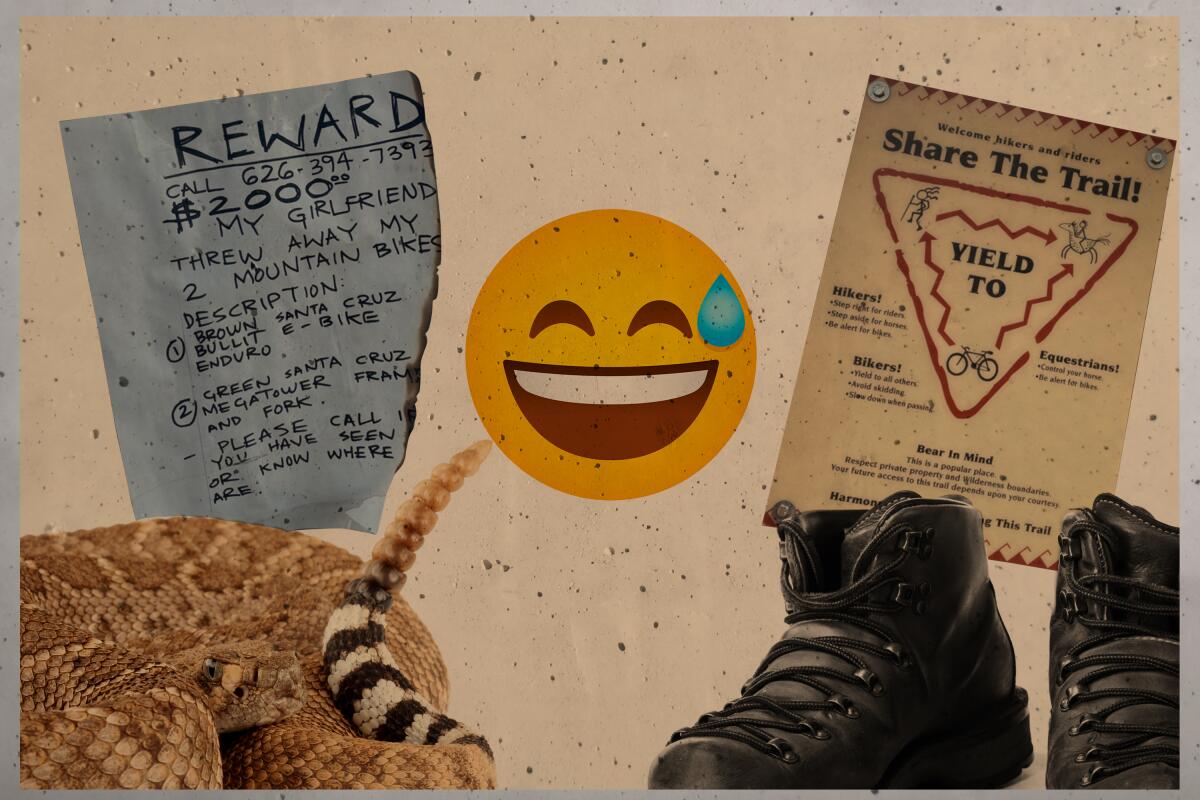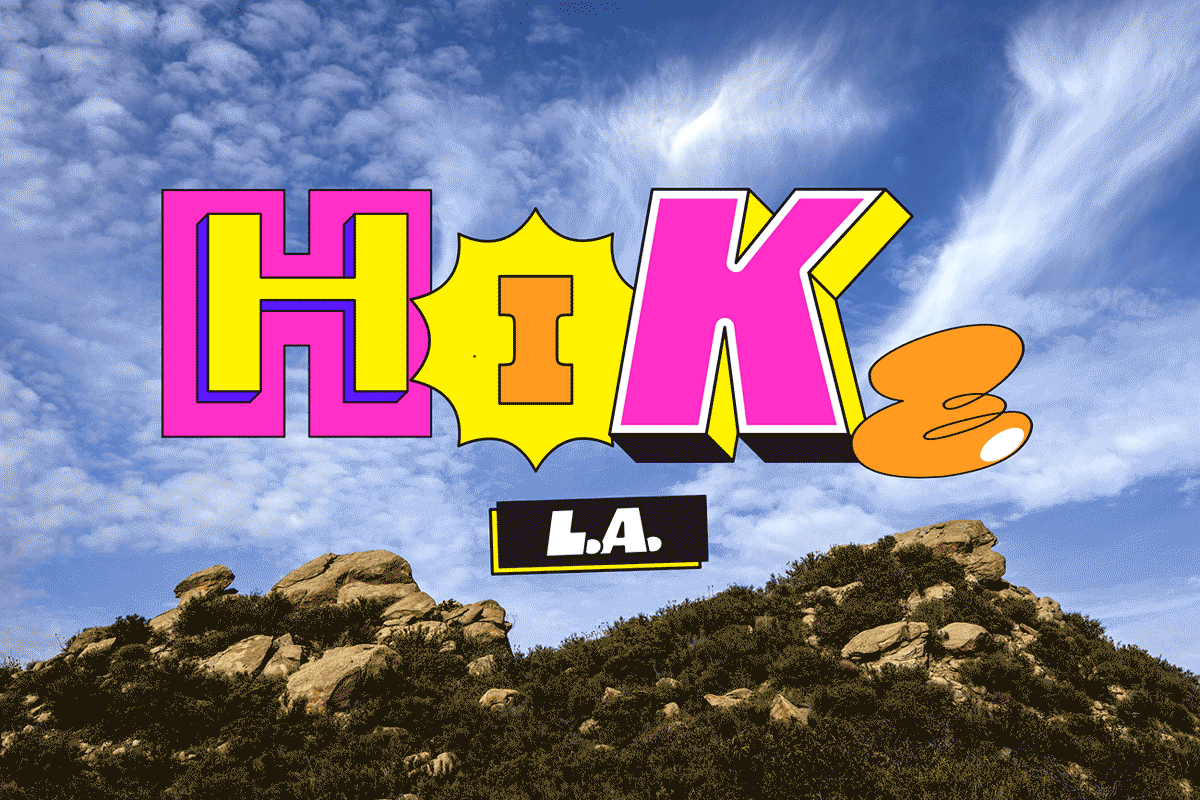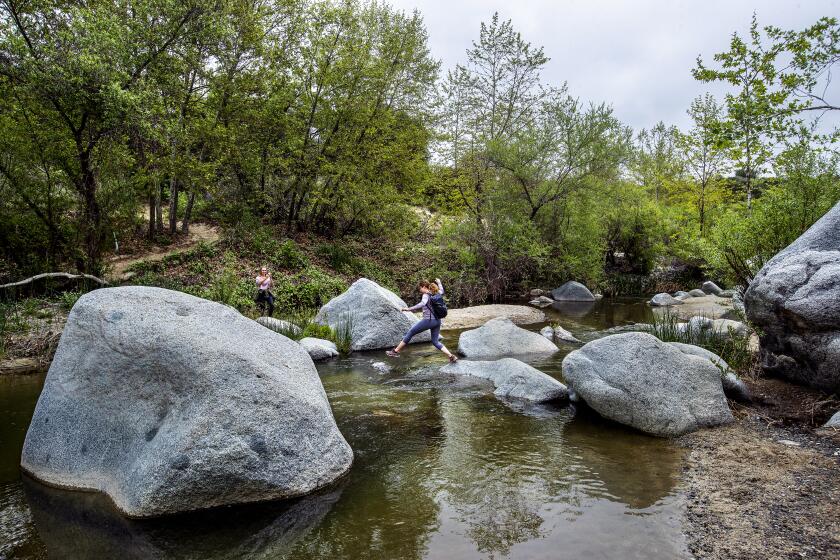Hiker’s handbook: How to handle the 14 most common awkward moments on the trails

- Share via
Good hiking memories far outweigh the not-so-good ones, but boy, do the bad ones stick with you. Gathered here are some diverse perspectives on how to be on your best behavior on the trails — and how to deal with those who aren’t.
Trail logistics and best practices
1. You’re in your zone, chugging along a narrow trail so close to the peak you can almost touch it. And then a rogue runner or biker plummets down, nearly wiping you out. (Bikers: Shout or use a noisemaker to alert others.) Uphill hikers have the right of way, so your safest move is to step to the uphill side of the trail as they zip by. On the way down, it can be awkward to yield to slow-moving uphill hikers. Sierra Club Angeles Chapter hike leader Will McWhinney’s advice? Step aside and distract yourself. “As I pull off I try to look otherwise engaged, like I don’t even care,” he said, so as to not rush those going uphill.
2. Report, rather than just traverse around, trail damage. Change your phone settings so “that the metadata for photos has coordinates,” said Robert Bittner, who leads L.A. Trail Hikers treks and volunteers with Santa Monica Mountains Trail Council. He says his trail maintenance team might cover two miles on a good day, so coordinates make it easier to locate places that need fixing. Snap a photo and report it to a local fire department or the Forest Service, if applicable.
3. Were brilliant blue lupine blooming from the dusty rocks? California quail hiding in the brush? If you see interesting flora or fauna on your route, local wildlife organizations want to know, Bittner said. Check out the iNaturalist app to see how you can contribute to community science. There’s an L.A. BioBlitz challenge on through Aug. 7 that welcomes your photos of animals, insects and plants.
Whether you’re looking for ocean views or desert landscapes or soaring mountain peaks, Los Angeles offers miles upon miles of strikingly different trails.
4. Unplanned bathroom breaks can sully a pleasant hike. No.1 is easy — just squat and go while a buddy plays lookout. If it’s the dreaded No. 2, dig a hole far from water sources and cover it when you’re done. Kelsey Lynn, one of the three co-founders of L.A. Hike Club, recommends topping it with a hefty rock. “There’s nothing worse than digging a hole and realizing someone’s already used that spot,” she said. Lynn also carries waste bags for emergencies. There are compostable bags, odor-neutralizing ones, even some that turn solid waste into a stable gel for easy transport.
5. L.A. heat is no joke. So approach a distressed hiker with compassion while checking for heat stroke or exhaustion. “You can immediately tell from their demeanor and expression” that something is wrong,” Bittner said. He says hello and asks how the person is doing, then points out what concerns him and asks how he can help. Bittner carries extra water and baby aspirin, which may help combat altitude sickness. Stay with the person until their condition improves or help arrives, offering what you can — even if it’s just a friendly face.
6. Fallen hikers require a similar strategy. Lynn recalled a Runyon Canyon trip where someone had lost their balance and needed help. Her advice? “Help, and don’t assume others will.” It’s perfectly OK to want to disconnect while you’re hiking, but “even if you turn it off, bring a cellphone in case you need to turn it on,” she said.
Pesky people
7. If someone gets “too close for comfort, especially with COVID,” step aside for a water break and let them by, said Madison Powers, another L.A. Hike Club founder. She said people have even tried to join her trio as they’re scouting hikes: She tells the person that they’re having a personal discussion that day but invites them to their large group hikes, which are capped at 50 people.
Get The Wild newsletter.
The essential weekly guide to enjoying the outdoors in Southern California. Insider tips on the best of our beaches, trails, parks, deserts, forests and mountains.
You may occasionally receive promotional content from the Los Angeles Times.
8. Call us crazy, but we think the best hiking soundtrack is the wind whistling through the trees and the idle chatter of your fellow outdoors people — and we’ve all heard too-loud music coming from a speaker or boombox. (Times outdoors writer Mary Forgione recalls a recent Mt. Hollywood hike being interrupted by Eddie Murphy’s “Boogie in Your Butt.”) Bittner asks them to “dial it way down or turn it off.” Andrea Rojas of L.A. Hike Club says to “leave some distance” between you and the music lovers by stepping aside for a break: “[We] don’t want to cause a disturbance.”
9. Hiking in a large group is great, but getting around one can be a hassle. “Our whole group cheers and high-fives people as we pass to keep the energy up,” Lynn said. “I read their body language because you don’t want to get into an altercation,” Bittner said. If it looks safe, embrace the awkwardness and ask to get around them. By the way, Bittner recommends splitting into smaller pods if your group exceeds 10 people.
Equity and safety in nature
10. You don’t want to stoke the flames of a tense political discussion or encourage unwanted advances, especially if you don’t know how someone will react, so use Bittner’s phrase to shut it down: “I understand we don’t agree about this, but that gives you no right to violate my space.” Victor Romo started Queer Hike L.A. this year “to create an environment where queer and trans folks feel safe,” he said in an Instagram DM. “Where we aren’t afraid to take up space to be seen and heard. I encourage folks who may not feel safe hiking alone to look up hiking groups — there is power and safety in numbers.”
11. “As a fat, brown queer person, [I’m] often met with backhanded compliments,” Romo said. “Telling a fat or disabled person ‘Wow — you’re so inspiring’ on a hiking trail is not as encouraging as you think.” Jelani Nattey founded Black Men Hike L.A. An older white man once asked the group, “Do you do this once a year?” — as if it was a Black History Month event ... in April. “These types of micro-aggressions force BIPOC to feel like we have to validate our existence in particular places, the very thing we’re trying to escape and recover from by enjoying nature,” Nattey said. “Nature is for everyone, and it doesn’t require a special occasion for groups of people to enjoy its benefits.”
Snakes and dogs and litterbugs, oh my
12. The fear of snakes is usually blown out of proportion, but they do present a threat. Use your size to your advantage: The snake is way more scared of you than you are of it. Look at it, back up and stand still until it slithers away. A venomous rattlesnake is more likely to try to defend itself (the diamond-shaped head and rattler will help you identify one).
Nature preserves provide a quiet alternative to national and state parks and a more intimate glimpse of nature.
13. It doesn’t matter how nice your dog is: The sign says to keep them leashed, and no one wants it jumping on them. So keep your dog on a leash 6 feet or shorter. If you feel safe, remind people of the rules if their dog is wandering. Plus keeping your mutt leashed and close protects them from coyotes that may be in the area.
14. Litterbugs are a common nuisance. Why bag your dog’s poop if you’re going to leave it there! McWhinney has packed out more than 50,000 pieces of trash since March 2020. “I don’t curse anyone as I’m picking up trash,” he said. “Most of the time I blame packaging engineers, not people.” Do your best to keep flimsy wrappers with you and leave the trail better than you found it. If you see someone deliberately littering, as McWhinney has, all it takes is a simple, “Hey, you dropped your water bottle!” They’ll probably bluster a bit and then retrieve it.
More to Read
Sign up for The Wild
We’ll help you find the best places to hike, bike and run, as well as the perfect silent spots for meditation and yoga.
You may occasionally receive promotional content from the Los Angeles Times.













